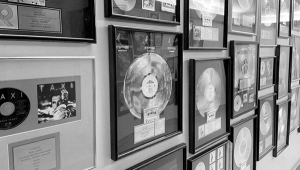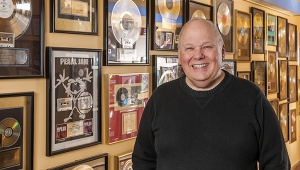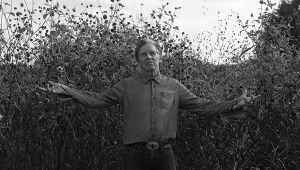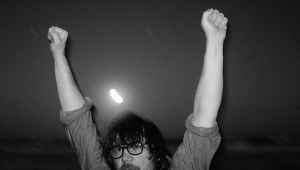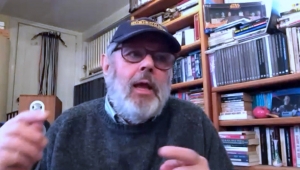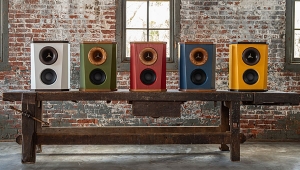| Columns Retired Columns & Blogs |
Jim Thiel: A Coherent Source
There was something odd about the clock on Jim Thiel's office wall. I didn't get it at first, other than noting that instead of the minutes being marked off at 12 five-minute intervals, Jim's clock had 24 markings. That was it: as well as the number "12" in its usual place at the top of the face, there was another "12" at the bottom, where the "6" usually is. The clock that Jim built was typical of everything this laconic loudspeaker engineer is involved in: logical, functional, and different from what anyone else in the same field does. In his cigarette-strained drawl, Jim explained that the short hand of his clock always points toward the sun: directly up at noon, directly down at midnight. That's the way a clock should be, declared Jim, and when you're in his company, it's hard to see how he could be wrong.
 In 1998, Thiel Audio Products, the company that Jim owns with his long-time business partner Kathy Gornik, celebrates the 20th anniversary of its first Coherent Source loudspeaker, the Thiel 03, designed by Jim. And in January 1998, at the annual Consumer Electronics Show, Thiel announced its latest Coherent Source loudspeakers: the long-awaited replacement for the CS2 2, the CS2.3 ($3300/pair), and the CS7.2—both designed, of course, by Jim, and both manufactured, from soup to nuts, in Thiel's Lexington, Kentucky factory, in the heart of horse country.
In 1998, Thiel Audio Products, the company that Jim owns with his long-time business partner Kathy Gornik, celebrates the 20th anniversary of its first Coherent Source loudspeaker, the Thiel 03, designed by Jim. And in January 1998, at the annual Consumer Electronics Show, Thiel announced its latest Coherent Source loudspeakers: the long-awaited replacement for the CS2 2, the CS2.3 ($3300/pair), and the CS7.2—both designed, of course, by Jim, and both manufactured, from soup to nuts, in Thiel's Lexington, Kentucky factory, in the heart of horse country.
I've talked speakers with Jim on many occasions over the past decade, and recently had two opportunities to pin him down on tape: once in Lexington and once in Stereophile's office in Santa Fe. (Thiel President Kathy Gornik also makes a guest appearance.) But one thing I've never understood is why anyone other than a masochist would want to get involved in loudspeaker design. The hours are long, the work difficult, and the rewards hard to predict. Jim, who got into audio when he was 12 by repairing radios and audio gear, typically didn't see it that way:
Jim Thiel: I wanted to have my own business and thought that loudspeakers were something that I would enjoy doing. I had been experimenting with loudspeakers for years, designing loudspeakers for people in rock'n'roll bands and things like that. I got tired of putting more and more effort into the design stage to get a speaker just right, only to make one, two, or three units. If I was going to put a lot of work in designing a product, selling thousands of the same unit would be [more rewarding].
The first loudspeaker system that we marketed under the Thiel name was the Model 01, a small two-way system that used an electronic equalizer to extend the bass response down to 30 cycles. We started selling that in 1976. The next model, the 02, was a smaller speaker. Used a 6½" driver. And about that time, I started thinking a lot more seriously about not just making a good product, but making a product that I hoped would be better than any others available.
I started giving a lot of thought to the inherent limits and problems of dynamic speakers and identified one area: the phase and time distortion that's introduced by typical high-order crossover networks, and the fact that the drive-units are not mounted coincident with each other. I spent a lot of time trying to eliminate this phase distortion and eventually decided to bite the bullet and use the first-order crossover system approach. That gives you technically perfect results. Not only do you end up with no phase distortion, you also end up with a uniform power response and a uniform amplitude response. The downside is that the drivers have to operate over a much wider bandwidth.
John Atkinson: But if you have spaced drive-units, aren't there going to be axes where you get acoustic cancellation between those drive-units?
Thiel: Yes, this is true. But we must distinguish between the total power output of the drive-units and that of the speaker unit. [With a first-order system,] the total power output over all radiated angles is constant. So you do not suffer any deficiency in total power reverberant energy in the room at the crossover region—as you do, say, in the fourth-order system, where you have a 3dB depression of total power output of the speakers through the crossover frequency range.
It's true that you have "lobing," where at certain angles you will get cancellations between two drive-units. How severe of a problem this is depends upon the spacing of the drivers compared to the wavelength at the crossover frequency. So the closer you can space the drivers on the baffle and the lower in frequency the crossover point can be, the less of a problem this is. For that reason, we have never made a speaker that has an upper crossover frequency higher than 3000 cycles. We don't make systems that have a 5000- or 7000- or 10,000-cycle upper crossover limit because the wavelengths get so small that the driver spacing becomes very, very significant. So because we have a relatively low upper-crossover frequency and we keep the driver spacing—particularly between the midrange driver and tweeter—very small, about one wavelength spacing, the lobing problem is relatively minor. But it still does exist. And that is one of the practical limitations of first-order crossover systems.
Atkinson: Something that does not appear to be widely appreciated is that a first-order crossover does not inherently make a speaker system time-coherent. You also have to arrange for the acoustic centers of all the drive-units to be the same distance from the listener.
- Log in or register to post comments

